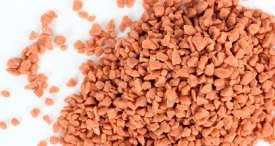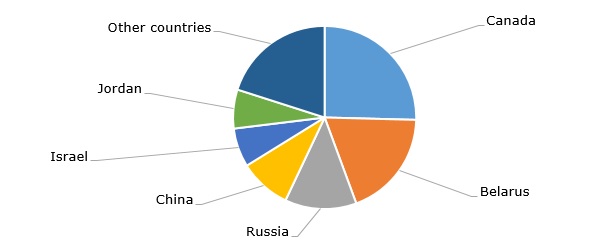World’s Top Potash Producing Countries
14 Dec 2018 • by Natalie Aster

LONDON – The world’s potash market is recovering for the third consecutive year. As of 2016, the market value reached USD 8 billion. In the coming years, the global potash market is projected to continue following an upward trend registering a modest growth at a CAGR of nearly 4%. The escalating demand for potash fertilizers is likely to act as the major market growth engine. By 2024, the market value may reach USD 11 billion. Owing to the thriving agricultural sector, APAC is poised to command the major revenue share of the global potash market in the years ahead.
Presently, the fertilizers industry accounts for the bulk share (over 90%) of the world’s total potash consumption volume. Potash is an essential nutrient that supports plant growth, enhances the resistance to diseases, intensifies water retention, and boosts crop productivity. A small proportion goes for the production of commodities like soap. Small quantities of potash are also used in the manufacturing of different potassium-bearing chemicals, for instance, soap, detergents, de-icing agents, pharmaceuticals, water conditioners, ceramics, amid others.
Potash Reserves
The world’s totaled reserves of potash are estimated at approximately 3.9 billion metric tons. The most abundant potash deposits are found in Canada – the country commands a share of over 23% of the global reserves. Saskatchewan accounts for the biggest chunk of the Canadian potash reserves. Belarus holds the second largest potash deposits across the globe, estimated at about 750 million metric tons (MMT) which is equivalent to appr. 17.4% of the global reserves. Russia possesses the third biggest potash reserves – nearly 11.6% of the world’s total.
Structure of the global potash reserves by country, 2017

Potash Production
The volume of the global potash production demonstrated notable fluctuations during the recent decade. The record low volume of potash was produced in 2009 – nearly 20.8 MMT. On the back of oversupply concerns, the world’s output of potash tended to decline in 2015 and 2016. As of 2016, it totaled some 39 MMT. However, spurred by the mounting demand, the global production of potash managed to register a healthy growth in 2017 and came to the volume of 42 MMT.
Global potash production volume during 2000-2017 (in MMT)
.jpg)
Globally, the consumption of potash is set to be on the rise owing to the strong demand from the agricultural sector which remains the major source of food for the rapidly-growing global population, a significant provider of fibres for the textile industries and also an important supplier of biofuel. The global consumption of potash may go beyond 45.6 MMT by the year 2021. Regionally, the highest demand for potash is predicted to be registered in Asia and South America. The upturn of the global demand is poised to encourage further growth in the world’s potash production. Besides, a number of new mines in such countries as Belarus, Spain, Russia, and China are anticipated to come online till 2021. These new potash projects could add some 15 MMT to the global potash output by 2021.
At present, only 12 countries are engaged in potash production, whilst more than 150 countries are active consumers of this mineral.
Five Leading Potash Producing Countries in the World:
5. GERMANY
Germany rounds out the list of the top five producers of potash with an output volume of 2.9 MMT in the year 2017. This is a slight YoY increase from 2.8 MMT of potash produced in the country in 2016. The first potash mines in the country were established in the late 19th century, and since then the production of potash in Germany has been gradually increasing along with the introduction of new mines. K+S AG is the leading potash-producing company in Germany. It operates six mines in three districts.
4. CHINA
China holds the fourth place in the world in terms of potash production volume. In 2016 and 2017, the annual production of potash in China remained at the same level – nearly 6.2 MMT. Historically, China has been recognised as one of the biggest consumers of potash worldwide. Nowadays, it accounts for almost 20% of the world’s total potash consumption volume. Alongside the large-scale domestic production, China also imports a huge amount of potash.
3. BELARUS
With the potash production volume of 6.4 MMT in 2017, Belarus ranks the third largest producer of potasharound the world.
The state-owned company Belaruskali operates six mines and four processing plants. Despite a fatal accident this year at one of the company’s mines, the production hasn’t been affected and continued to increase. In the next three years, Belaruskali’s production is expected to see further growth with the opening of several new mines.
2. RUSSIA
Russia is the second leading producer of potash on the global arena. In 2017, the domestic potash production in Russia exhibited a notable growth and reached the volume of 7.2 MMT – up from 6.48 MMT produced in 2016. Large-scale extraction of potash in the country is conducted on Talitsky mine and Synnyr mine.
Uralkali is the dominant potash-producing company in Russia. The company operates five potash mines and seven milling factories, it controls the entire chain from the mining activities to refining and marketing of potash and some other by-products.
1. CANADA
Canada tops the list of the world’s leading potash producing-countries, accounting for almost 30% of the global output volume. The Canadian potash production ramped up from 10 MMT in the year 2016 to reach 12 MMT in 2017.
Natural potash deposits were discovered in the country in the province of Saskatchewan in 1943, and active mining began in the year 1951. The potash reserves in Saskatchewan are the largest known worldwide.
The Mosaic Company is the dominating miner in Canada. Moreover, in early 2018, Agrium and Potash Corporation of Saskatchewan merged to form the leading potash company by capacity – Nutrien, which is valued at around USD 36 billion.
© MarketPublishers.com, 2018
Analytics & News
